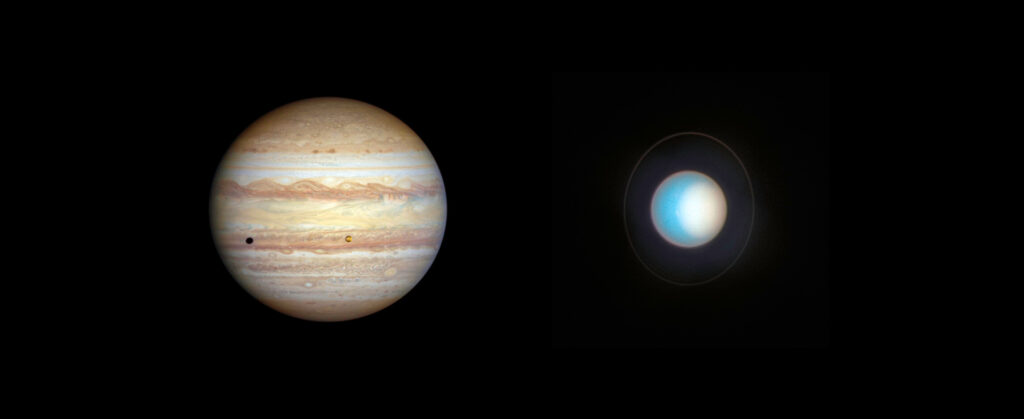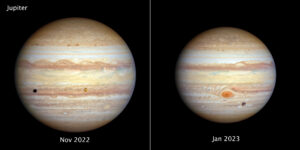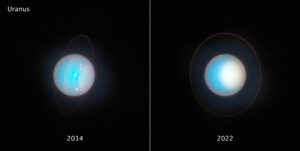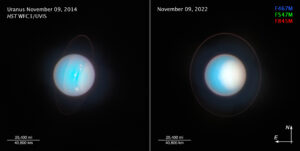Webb reveals new details in Jupiter’s aurora
The NASA/ESA/CSA James Webb Space Telescope has captured new details of the auroras on our Solar System’s largest planet. The dancing lights observed on Jupiter are hundreds of times brighter than those seen on Earth. With Webb’s advanced sensitivity, astronomers have studied the phenomena to better understand Jupiter’s magnetosphere.

These observations of Jupiter’s auroras were captured with Webb’s Near-InfraRed Camera (NIRCam) on 25 December 2023 (F335M filter). Scientists found that the emission from the trihydrogen ion, known as H3+, is far more variable than previously believed. H3+ is created by the impact of high energy electrons on molecular hydrogen. Because this emission shines brightly in the infrared, Webb’s instruments are well equipped to observe it.
Credit: ESA/Webb, NASA, CSA, J. Nichols (University of Leicester), M. Zamani (ESA/Webb)
The auroras are created when high-energy particles enter a planet’s atmosphere near its magnetic poles and collide with atoms of gas. Not only are the auroras on Jupiter huge in size, they are also hundreds of times more energetic than auroras on Earth. Here, auroras are caused by solar storms — when charged particles rain down on the upper atmosphere, excite gases and cause them to glow colours of red, green and purple. Meanwhile, Jupiter has an additional source for its auroras; the strong magnetic field of the gas giant grabs charged particles from its surroundings. This includes not only the charged particles within the solar wind but also the particles thrown into space by its orbiting moon Io, known for its numerous and large volcanoes. Io’s volcanoes spew particles that, remarkably, escape the moon’s gravity and orbit Jupiter. A barrage of charged particles unleashed by the sun during solar storms also reaches the planet. Jupiter’s large and powerful magnetic field captures charged particles and accelerates them to tremendous speeds. These speedy particles slam into the planet’s atmosphere at high energies, which excites the gas and causes it to glow.
Now, Webb’s unique capabilities are providing new insights into the auroras on Jupiter. The telescope’s sensitivity allows astronomers to increase the shutter speed in order to capture fast-varying auroral features. New data was captured with Webb’s Near-InfraRed Camera (NIRCam) on Christmas Day 2023 by a team of scientists led by Jonathan Nichols from the University of Leicester in the United Kingdom.
“What a Christmas present it was – it just blew me away!” shared Nichols. “We wanted to see how quickly the auroras change, expecting it to fade in and out ponderously, perhaps over a quarter of an hour or so. Instead we observed the whole auroral region fizzing and popping with light, sometimes varying by the second.”

These observations of Jupiter’s auroras (shown on the left of the above image) were captured with Webb’s Near-InfraRed Camera (NIRCam) on 25 December 2023 (F335M filter). Scientists found that the emission from the trihydrogen ion, known as H3+, is far more variable than previously believed. H3+ is created by the impact of high energy electrons on molecular hydrogen. Because this emission shines brightly in the infrared, Webb’s instruments are well equipped to observe it. The image on the right shows the planet Jupiter to indicate the location of the observed auroras, which was originally published in 2023 (F164N, F212N, and F360M filters).
Credit: NASA, ESA, CSA, STScI, Ricardo Hueso (UPV), Imke de Pater (UC Berkeley), Thierry Fouchet (Observatory of Paris), Leigh Fletcher (University of Leicester), Michael H. Wong (UC Berkeley), Joseph DePasquale (STScI), J. Nichols (University of Leicester), M. Zamani (ESA/Webb)
The team’s data found that the emission from the trihydrogen ion, known as H3+, is far more variable than previously believed. The observations will help develop scientists’ understanding of how Jupiter’s upper atmosphere is heated and cooled.
The team also uncovered some unexplained observations in their data.
“What made these observations even more special is that we also took pictures simultaneously in the ultraviolet with the NASA/ESA Hubble Space Telescope,” added Nichols. “Bizarrely, the brightest light observed by Webb had no real counterpart in Hubble’s pictures. This has left us scratching our heads. In order to cause the combination of brightness seen by both Webb and Hubble, we need to have an apparently impossible combination of high quantities of very low energy particles hitting the atmosphere – like a tempest of drizzle! We still don’t understand how this happens.”
The team now plans to study this discrepancy between the Hubble and Webb data and to explore the wider implications for Jupiter’s atmosphere and space environment. They also intend to follow up this research with more Webb observations, which they can compare with data from NASA’s Juno spacecraft to better explore the cause of the enigmatic bright emission. These insights may also support the European Space Agency’s Jupiter Icy Moons Explorer, Juice, which is en route to Jupiter to make detailed observations of the giant gas planet and its three large ocean-bearing moons – Ganymede, Callisto and Europa. Juice will take a look at Jupiter’s auroras with seven unique scientific instruments, including two imagers. These close-up measurements will help us understand how the planet’s magnetic field and atmosphere interact, as well as the effect that charged particles from Io and the other moons have on Jupiter’s atmosphere.

These observations of Jupiter’s auroras were captured with Webb’s Near-InfraRed Camera (NIRCam) on 25 December 2023 (F335M filter). Scientists found that the emission from the trihydrogen ion, known as H3+, is far more variable than previously believed. H3+ is created by the impact of high energy electrons on molecular hydrogen. Because this emission shines brightly in the infrared, Webb’s instruments are well equipped to observe it.
The timestamps indicated in the lower right corner of each image indicates the time (UTC) when these observations were taken on 25 December 2023.
Credit: ESA/Webb, NASA, CSA, J. Nichols(University of Leicester), M. Zamani (ESA/Webb)
These results were obtained from data using Webb’s Cycle 2 observing programme #4566 and Hubble’s observing programme #17471. The results were published today in Nature Communications.
Press release from ESA Webb.

















